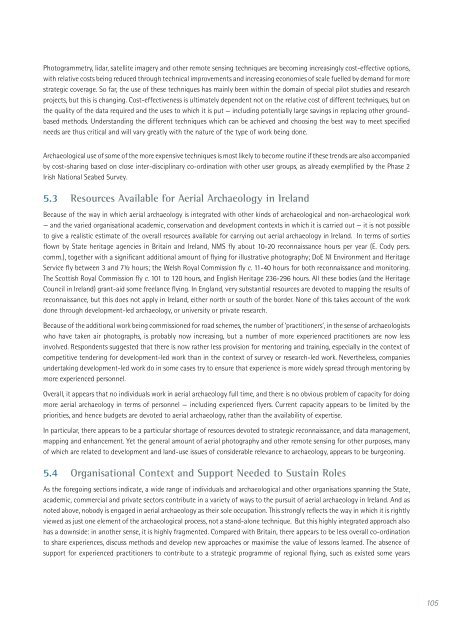Aerial Archaeology in Ireland - The Heritage Council
Aerial Archaeology in Ireland - The Heritage Council
Aerial Archaeology in Ireland - The Heritage Council
You also want an ePaper? Increase the reach of your titles
YUMPU automatically turns print PDFs into web optimized ePapers that Google loves.
Photogrammetry, lidar, satellite imagery and other remote sens<strong>in</strong>g techniques are becom<strong>in</strong>g <strong>in</strong>creas<strong>in</strong>gly cost-effective options,<br />
with relative costs be<strong>in</strong>g reduced through technical improvements and <strong>in</strong>creas<strong>in</strong>g economies of scale fuelled by demand for more<br />
strategic coverage. So far, the use of these techniques has ma<strong>in</strong>ly been with<strong>in</strong> the doma<strong>in</strong> of special pilot studies and research<br />
projects, but this is chang<strong>in</strong>g. Cost-effectiveness is ultimately dependent not on the relative cost of different techniques, but on<br />
the quality of the data required and the uses to which it is put — <strong>in</strong>clud<strong>in</strong>g potentially large sav<strong>in</strong>gs <strong>in</strong> replac<strong>in</strong>g other groundbased<br />
methods. Understand<strong>in</strong>g the different techniques which can be achieved and choos<strong>in</strong>g the best way to meet specified<br />
needs are thus critical and will vary greatly with the nature of the type of work be<strong>in</strong>g done.<br />
Archaeological use of some of the more expensive techniques is most likely to become rout<strong>in</strong>e if these trends are also accompanied<br />
by cost-shar<strong>in</strong>g based on close <strong>in</strong>ter-discipl<strong>in</strong>ary co-ord<strong>in</strong>ation with other user groups, as already exemplified by the Phase 2<br />
Irish National Seabed Survey.<br />
5.3 Resources Available for <strong>Aerial</strong> <strong>Archaeology</strong> <strong>in</strong> <strong>Ireland</strong><br />
Because of the way <strong>in</strong> which aerial archaeology is <strong>in</strong>tegrated with other k<strong>in</strong>ds of archaeological and non-archaeological work<br />
— and the varied organisational academic, conservation and development contexts <strong>in</strong> which it is carried out — it is not possible<br />
to give a realistic estimate of the overall resources available for carry<strong>in</strong>g out aerial archaeology <strong>in</strong> <strong>Ireland</strong>. In terms of sorties<br />
flown by State heritage agencies <strong>in</strong> Brita<strong>in</strong> and <strong>Ireland</strong>, NMS fly about 10-20 reconnaissance hours per year (E. Cody pers.<br />
comm.), together with a significant additional amount of fly<strong>in</strong>g for illustrative photography; DoE NI Environment and <strong>Heritage</strong><br />
Service fly between 3 and 7½ hours; the Welsh Royal Commission fly c. 11-40 hours for both reconnaissance and monitor<strong>in</strong>g.<br />
<strong>The</strong> Scottish Royal Commission fly c. 101 to 120 hours, and English <strong>Heritage</strong> 236-296 hours. All these bodies (and the <strong>Heritage</strong><br />
<strong>Council</strong> <strong>in</strong> <strong>Ireland</strong>) grant-aid some freelance fly<strong>in</strong>g. In England, very substantial resources are devoted to mapp<strong>in</strong>g the results of<br />
reconnaissance, but this does not apply <strong>in</strong> <strong>Ireland</strong>, either north or south of the border. None of this takes account of the work<br />
done through development-led archaeology, or university or private research.<br />
Because of the additional work be<strong>in</strong>g commissioned for road schemes, the number of ‘practitioners’, <strong>in</strong> the sense of archaeologists<br />
who have taken air photographs, is probably now <strong>in</strong>creas<strong>in</strong>g, but a number of more experienced practitioners are now less<br />
<strong>in</strong>volved. Respondents suggested that there is now rather less provision for mentor<strong>in</strong>g and tra<strong>in</strong><strong>in</strong>g, especially <strong>in</strong> the context of<br />
competitive tender<strong>in</strong>g for development-led work than <strong>in</strong> the context of survey or research-led work. Nevertheless, companies<br />
undertak<strong>in</strong>g development-led work do <strong>in</strong> some cases try to ensure that experience is more widely spread through mentor<strong>in</strong>g by<br />
more experienced personnel.<br />
Overall, it appears that no <strong>in</strong>dividuals work <strong>in</strong> aerial archaeology full time, and there is no obvious problem of capacity for do<strong>in</strong>g<br />
more aerial archaeology <strong>in</strong> terms of personnel — <strong>in</strong>clud<strong>in</strong>g experienced flyers. Current capacity appears to be limited by the<br />
priorities, and hence budgets are devoted to aerial archaeology, rather than the availability of expertise.<br />
In particular, there appears to be a particular shortage of resources devoted to strategic reconnaissance, and data management,<br />
mapp<strong>in</strong>g and enhancement. Yet the general amount of aerial photography and other remote sens<strong>in</strong>g for other purposes, many<br />
of which are related to development and land-use issues of considerable relevance to archaeology, appears to be burgeon<strong>in</strong>g.<br />
5.4 Organisational Context and Support Needed to Susta<strong>in</strong> Roles<br />
As the forego<strong>in</strong>g sections <strong>in</strong>dicate, a wide range of <strong>in</strong>dividuals and archaeological and other organisations spann<strong>in</strong>g the State,<br />
academic, commercial and private sectors contribute <strong>in</strong> a variety of ways to the pursuit of aerial archaeology <strong>in</strong> <strong>Ireland</strong>. And as<br />
noted above, nobody is engaged <strong>in</strong> aerial archaeology as their sole occupation. This strongly reflects the way <strong>in</strong> which it is rightly<br />
viewed as just one element of the archaeological process, not a stand-alone technique. But this highly <strong>in</strong>tegrated approach also<br />
has a downside: <strong>in</strong> another sense, it is highly fragmented. Compared with Brita<strong>in</strong>, there appears to be less overall co-ord<strong>in</strong>ation<br />
to share experiences, discuss methods and develop new approaches or maximise the value of lessons learned. <strong>The</strong> absence of<br />
support for experienced practitioners to contribute to a strategic programme of regional fly<strong>in</strong>g, such as existed some years<br />
105

















